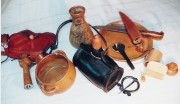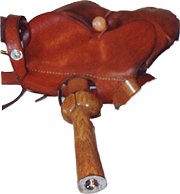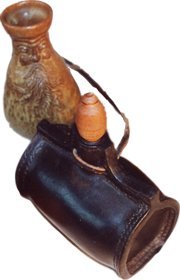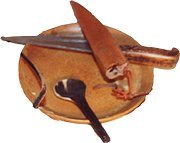
|
Clicking on the picture will take you to a much larger version, but it will download slower.
All these items, and the ones in the other picture below, are the sort of thing many ordinary people might own. Some of them you would carry round with you as a matter of course, some you might keep in your home, to use as needed.
|

|
The pouch on a belt has the belt threaded through it. This makes it harder for the cutpurse, or purse thief, to get it. The dagger in its small sheath stuck just behind it is of a pattern very popular with medieval men, and later with Tudor men, and even later still. Lots of older books politely call it a kidney dagger, because of the shape of the carving on the handle, but the real name is a bollock dagger. This is not trying to be needlessly vulgar - it's what they called them!
|

|
The drinking jug, of the type of pottery called stoneware, has a face on the side. These jugs were later named after Cardinal Bellamane (I hope I've spelt that right) but in the first place, so I am told, the face was there simply as a sort of trade mark. Such jugs, in larger sizes, were used to import wine from Germany, where this style of pottery was used before it was used in England. The mark showed which maker it came from, apparently.
The leather drinking bottle is called a costrel. It's made of good thick leather, and is lined with pitch, as in tar, to make it water-tight. While the pitch will crack if the leather is squeezed, it's surprising how strong it is.
Note to people who meet people with costrels: it's not a good idea to squeeze them to see how strong they are!
|

|
Pottery was reasonably cheap, but was likely to break. (SO that much hasn't changed!) This trencher/platter/ plate, and the bowl are both of pot, but wooden ones were often used. (I just didn't have the wooden one to hand when I took the photo!)
The eating spoon is made of horn - as in cow horn. When it's worked with hot water it can be moulded to shape. It's a bit like the nearest thing to medieval plastic.
The knife is for eating. This one's a bit large, but everyone would carry his or her own eating knife. There isn't a fork. When forks came to England from Italy, they were used in the kitchen, or on the table to help in carving meat. When later on, during the Tudor time, they began to be used for eating, they were thought to be a bit showy and not to be used by Real Men!
|
|
and bowl
|
|
While travellers would use these, they could be quite handy in the course of an ordinary out-of-doors day.
|

|
 Return to TABLE OF CONTENTS.
Return to TABLE OF CONTENTS.
 Return To Home Page
Return To Home Page
 Return to TABLE OF CONTENTS.
Return to TABLE OF CONTENTS.
 Return To Home Page
Return To Home Page
 Return To Home Page
Return To Home Page
 Return to top of this page.
Return to top of this page.
 Return to TABLE OF CONTENTS.
Return to TABLE OF CONTENTS.